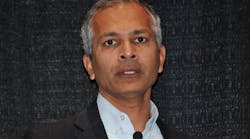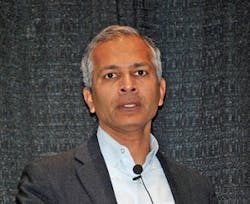"We wanted common systems across the Eli Lilly architecture.” Eli Lilly’s Wilfred Mascarenhas explained how a 15-year-old IT harmonization effort is now paying transformative dividends for the life sciences leader.
The 140-year legacy of innovation at Eli Lilly is impressive. Big, life-saving advances get brought up—insulin, the polio vaccine, penicillin.
That history makes Eli Lilly’s current, transformative mindset particularly laudable. And within an enterprise as massive as this, comprehensive transformation can be tricky. “There is complexity when implementing any solution here,” admitted Wilfred Mascarenhas, data & analytics advisor for quality information and digital solutions with the global pharmaceutical giant, who spoke during today’s Life Sciences Forum at Automation Fair 2019 on the topic of “Facility of the Future: Transforming Manufacturing in Life Sciences.”
Rockwell Automation’s Dave Sharp, who hosted the forum, touched on that changing pharma landscape during his introduction. He explained how the industry is moving to personalized treatment, personalized medical devices, even personalized tissue. In this modern medical world, lot-size-one means one person, one patient, one life. “The users are driving change in the industry,” noted Sharp. And that disruption is creating opportunities for manufacturers, especially connected, flexible enterprises that can develop systems to create smaller batches and get products to market faster.
Connected, flexible enterprises like Eli Lilly.
With the increased complexity of the supply chain, explained Mascarenhas at the start of his talk, the old model of business is simply not sustainable. At the heart of this new model at Lilly is an evolved architecture that was strategically developed over the past half-decade.
Mascarenhas described how, in 2004, Lilly executives prioritized harmonization throughout all IT systems. “We wanted common systems across the Eli Lilly architecture. The same product-manufacturing processes across multiple sites. Common reference architectures. A centralized data lake that contains trusted information that could be applied across applications around the globe.”
At the start of the process, they contracted the Boston Consulting Group to identify key elements needed to properly develop and implement the strategy. BCG delivered nine. Mascarenhas highlighted two during the forum: data analytics, which drive the digital plant, and autonomous robots capable of delivering real-time data from the edge.
The Lilly team developed a new type of reference architecture that addresses key elements related to data analytics:
- Batch analytics with a strategy for proper organization;
- A stream-processing zone to enable real-time analytics emanating from smart machines;
- “Right-time”pulling of data from systems, as opposed to constant steaming of data; and,
- A sandbox in which scientists could develop models and deploy learnings back into systems.
Mascarenhas shared with the audience some best practices that emerged throughout this initiative:
- Develop and maintain good partnerships - The Lilly advisor noted that partnerships with vendors such as Rockwell Automation are critical to minimize the complexity of architectures to enable them to deliver faster results to market.
- Consider the people with the data and install proper governance - “Bringing data together only goes so far,” he said. “You must bring your people together and upskill them to make sure they can take advantage of this data-first approach.” Make sure you have the right stakeholders to take these efforts to the next level.
- Consider the users of the strategy - Develop a holistic, people-strategy to manage information and drive analytics efforts.
Heads nodded in the audience, surely from some professionals at global pharmaceutical companies like Lilly and some from much smaller enterprises.
The architecture at work
In the second half of the presentation, Matthew Laing, automation manager in Eli Lilly’s corporate engineering group, provided real-world examples of the concepts his colleague had just detailed.
During a recent energy-monitoring project, Laing’s team needed to use data analytics to find and remedy energy inefficiencies. As he described, the team prepped the data, identified knowledge gaps, then selected the proper technology to provide remedies. After early successes validated the approach, they templatized their efforts.
“We made a standard data model for energy monitoring,” he explained. “So whether you’re talking about energy efficiency with a boiler or a chiller, it should all look the same.”
The next step? Global rollout, of course. Because as nimble and open-to-change as this pharmaceutical behemoth may be, the beneficiaries of their work exist in 140-year-old relationships with partners and millions of customers that span the planet.
“The past looks great,” surmised Mascarenhas, “But we’re keenly looking at the future.”
The editors of Control are on-site at Automation Fair 2019 to bring you breaking news, innovations and insights from the event. Once the event is over, they will put together a report featuring the top news. Pre-order your copy today.






